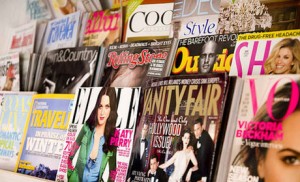September 23, 2013, by melissayoong
Reading Between the Headlines and Getting the Plot
Whenever I ask my students what they understand by the term ‘read’, they often equate it to vocabulary comprehension – in other words, if I understand most of the words in the text, I can read well. However, this is a flawed assumption since reading also entails, among other things, the ability to discern the underlying ideology of a text and, consequently, make critical judgments about the arguments presented.
One example where criticality is particularly important is when reading texts produced by the mass media. Whenever I drop by the salon to get my hair cut, the staff would plonk a stack of women’s magazines on the glass dressing table in front of me. Shiny happy female celebrities would smile widely at me from the covers of those dog-eared glossies, hands on their hips, gazing confidently into the camera. Between the covers, these magazines are chock full of tips and sisterly advice on all I need to know to get that “perfect bikini body”, to catch/keep a man, etc.
On the surface, this would seem like a clarion call: this is the age of Girl Power where women can be whoever we want to be, where we can have whatever we want, because we’re worth it. However, as we can see from our own daily conversations, there is often a difference between what we say and what we mean or imply. In other words, our attitudes and beliefs are frequently conveyed implicitly – and sometimes unconsciously – through our language choices. While anti-sexist language reform has been successful to a certain extent due to past feminist efforts, overt sexism has been replaced by indirect sexism, which, in the case of the media, tends to go uncontested since it perpetuates stereotypes and unfair expectations of women without explicitly disparaging females. Indeed, the message conveyed may seem pro-women – until the language used is analysed critically, such as by examining syntax, pronouns and connotation.
One dominant trope in media targeting women is that a woman’s beauty is her most important quality. I remember reading an article in a local newspaper about “celebrating” our body shapes and finding the clothes that best suits us in order to “make the most” of our figure. Although the verb “celebrate” could be interpreted as empowering women to accept one’s body rather than conforming to the expectation to be slim, due to the liberal sprinkling of directives such as “finding what best suits you”, “dress for your shape” and “make the most of your figure”, the dominant reading of the article remained that it is vital for women to look beautiful.
As you can see, the ability to read critical and recognise the ideology promoted by a writer requires more than vocabulary comprehension. In my next blog post, I’ll discuss more examples of how lifestyle magazines objectify women indirectly through the use of language.
Image: downloaded from http://www.journalism.co.uk/news/significant-circulation-decline-in-women-s-magazines/s2/a547910/ (23 Sep 2013), labelled as Copyright: khawkins04/Flickr. Licensed under Creative Commons
-
Post a comment

